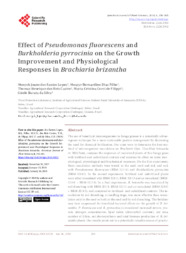Effect of Pseudomonas fluorescens and Burkholderia pyrrocinia on the growth improvement and physiological responses in Brachiaria brizantha.
Effect of Pseudomonas fluorescens and Burkholderia pyrrocinia on the growth improvement and physiological responses in Brachiaria brizantha.
Author(s): LOPES, M. J. dos S.; DIAS FILHO, M. B.; CASTRO, T. H. dos R.; FILIPPI, M. C. C. de; SILVA, G. B. da
Summary: The use of beneficial microorganisms in forage grasses is a potentially advantageous technique for a more sustainable pasture management by decreasing the need for chemical fertilization. Our aims were to determine the best method of microorganism inoculation on Brachiaria (Syn. Urochloa) brizantha cv. BRS Piata, compare the responses of inoculated plants of this forage grass with fertilized and unfertilized controls and examine its effect on some morphological, physiological and biochemical responses. On the first experiment, three inoculation methods were tested: in the seed, seed and soil, and soil, with Pseudomonas fluorescens (BRM-32111) and Burkholderia pyrrocinia (BRM-32113). In the second experiment, fertilized and unfertilized plants were either inoculated with BRM-32111, BRM-32113 and co-inoculated (BRM-32111 + BRM-32113). In a final experiment, B. brizantha was inoculated by soil drenching with BRM-32111, BRM-32113 and co-inoculated (BRM-32111 + BRM-32113), and compared to fertilized- and unfertilized-controls. The inoculation by soil drenching, at seedling stage, was more effective than inoculation only in the seed or both in the seed and by soil drenching. The fertilizer may have suppressed the beneficial bacterial effects on the growth of B. brizantha. P. fluorescens and B. pyrrocinia co-inoculated increased nitrate, protein, nitrogen concentration, Spad index (chlorophyll content), leaf area, number of tillers, net photosynthesis and total biomass production of B. brizantha plants. Our results point out to a potentially valuable source of practical information in the search of an eco-friendlier approach to increase pasture productivity.
Publication year: 2018
Types of publication: Journal article
Unit: Embrapa Eastern Amazon
Keywords: Bactéria, Brachiaria brizantha, Forragem, Fotossíntese, Grama, Nitrogênio, Pastagem, Pseudomonas Fluorescens
Observation
Some of Embrapa's publications are published as ePub files. To read them, use or download one of the following free software options to your computer or mobile device. Android: Google Play Books; IOS: iBooks; Windows and Linux: Calibre.
Access other publications
Access the Agricultural Research Database (BDPA) to consult Embrapa's full library collection and records.
Visit Embrapa Bookstore to purchase books and other publications sold by Embrapa.

